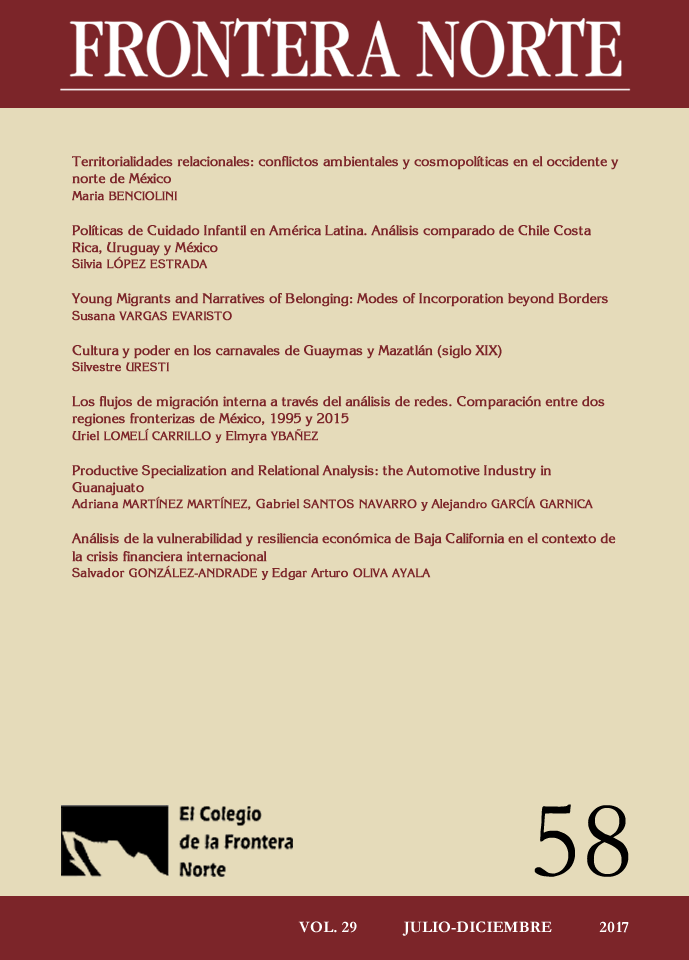Internal Migration flows through Network Analysis: A Comparison between Two Border Regions of Mexico, 1995 and 2015
Main Article Content
Abstract
Article Details
Authors publishing work in this journal agree to the following conditions:
Authors retain copyright and assign first publication rights to the journal Frontera Norte (RFN), with the texts registered under an Attribution-NonCommercial-NoDerivatives 4.0 International Creative Commons license (CC BY-NC-ND 4.0), which allows third parties to use published material provided they give credit to the authors and acknowledge this journal as the first publisher.
They authorize the reproduction, publication, translation, communication, and transmission of their paper and all accompanying material, publicly and in any form and by any means; its public distribution in as many copies as required; and public communication thereof in any form, including making it available to the public through electronic means or any other technology, and solely for dissemination and scientific, cultural, and non-commercial purposes.
Authors may enter into further independent contractual agreements for the non-exclusive distribution of the version of the paper published in this journal (for instance, to include it in an institutional repository or personal webpage, or publish it in a book), provided it is not for commercial purposes and they clearly state that the work was first published in Frontera Norte (RFN) [and add the corresponding bibliographical record: Author/s (Year). Title of paper. Frontera Norte, volume (number), pp. doi: xxxx].
To that end, authors must submit the form assigning ownership of first publication rights, duly completed and signed. This document is to be uploaded in PDF format as a complementary file on the OJS platform.
This work is released under an Attribution-NonCommercial-NoDerivatives 4.0 International Creative Commons license (CC BY-NC-ND 4.0)..
References
Anguiano, M. E. (1996). Frontera norte: migración interna e internacional. Cotidiano, (77), 19-23.
Bonacich, P. (1987). Power and Centrality: A Family of Measures. American journal of Sociology, 92(5), 1170-1182.
Borgatti, S. P. (2005). Centrality and network flow. Social Networks, 27(1), 55-71.
Borgatti, S. P. y Everett, M. G. (2006). A graph-theoretic perspective on centrality. Social Networks, 28(4), 466-484.
Corona Vázquez, R. (2000). Medición de la migración interestatal. Demos, (13), 8-10.
Freeman, L. C. (1978). Centrality in social networks conceptual clarification. Social Networks, 1(3), 215-239.
Garrocho Rangel, C., Jiménez López, E. y Álvarez Lobato, J. A. (2014). Estructura profunda de los flujos migratorios en México, 1990-2010. En Consejo Nacional de Población (Edit.), La situación demográfica de México 2014 (87-118). México: Conapo.
Hanneman, R. A. y Riddle, M. (2005). Introduction to Social Network Methods. Estados Unidos: University of California, Riverside. Recuperado de http://faculty. ucr.edu/~hanneman/
Instituto Nacional de Estadística, Geografía e Informática. (1995). Conteo de Población y Vivienda. México: INEGI. Recuperado de http://www.beta.inegi.org.mx/proyectos/ccpv/1995/
Instituto Nacional de Estadística y Geografía. (2015). Encuesta Intercensal. México: Inegi. Recuperado de http://www.beta.inegi.org.mx/proyectos/enchogares/especiales/intercensal/
Opsahl, T., Agneessens, F. y Skvoretz, J. (2010). Node centrality in weighted networks: Generalizing degree and shortest paths. Social Networks, 32(3), 245-251.
Pérez Campuzano, E. y Santos Cerquera, C. (2013). Tendencias recientes de la migración interna en México. Papeles de población, 19(76), 53-88.
Sobrino, J. (2010). Migración interna en México durante el siglo XX. México: Consejo Nacional de Población.
The New York Times. (3 de abril de 1933). Emotions Mapped by New Geography. Recuperado de http://diana-jones.com/wp-content/uploads/Emotions-Mapped- by-New-Geography.pdf
Wasserman, S. y Faust, K. (1994). Social Network Analysis: Methods and Applications (vol. 8). Reino Unido: Cambridge University Press.
Wellman, B. (2000). El análisis estructural: del método y la metáfora a la teoría y la sustancia. Política y Sociedad, (33), 11-40.
White, M. J. (Edit.). (2016). International Handbook of Migration and Population Distribution. Países Bajos: Springer.
Willekens, F. (2016). Migration flows: Measurement, analysis and modeling. En White, M. J. (Edit.), International Handbook of Migration and Population Distribution (225-241). Países Bajos: Springer.
Ybáñez Zepeda, E. (2000). Algunas características demográficas de la población de la frontera México-Estados Unidos. Frontera Norte, 12(24), 159-166.

